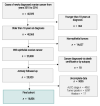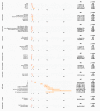Impact of the Area of Residence of Ovarian Cancer Patients on Overall Survival
- PMID: 36497469
- PMCID: PMC9736843
- DOI: 10.3390/cancers14235987
Impact of the Area of Residence of Ovarian Cancer Patients on Overall Survival
Abstract
Survival disparities persist in ovarian cancer and may be linked to the environments in which patients live. The main objective of this study was to analyze the global impact of the area of residence of ovarian cancer patients on overall survival. The data were obtained from the Surveillance, Epidemiology and End Results (SEER) database. We included all the patients with epithelial ovarian cancers diagnosed between 2010 and 2016. The areas of residence were analyzed by the hierarchical clustering of the principal components to group similar counties. A multivariable Cox proportional hazards model was then fitted to evaluate the independent effect of each predictor on overall survival. We included a total of 16,806 patients. The clustering algorithm assigned the 607 counties to four clusters, with cluster 1 being the most disadvantaged and cluster 4 having the highest socioeconomic status and best access to care. The area of residence cluster remained a statistically significant independent predictor of overall survival in the multivariable analysis. The patients living in cluster 1 had a risk of death more than 25% higher than that of the patients living in cluster 4. This study highlights the importance of considering the sociodemographic factors within the patient's area of residence when developing a care plan and follow-up.
Keywords: area of residence; hierarchical cluster algorithm; ovarian cancer; sociodemographic factor.
Conflict of interest statement
The authors declare no conflict of interest.
Figures










References
-
- Gomez S.L., Shariff-Marco S., DeRouen M., Keegan T.H.M., Yen I.H., Mujahid M., Satariano W.A., Glaser S.L. The Impact of Neighborhood Social and Built Environment Factors across the Cancer Continuum: Current Research, Methodological Considerations, and Future Directions. Cancer. 2015;121:2314–2330. doi: 10.1002/cncr.29345. - DOI - PMC - PubMed
LinkOut - more resources
Full Text Sources

